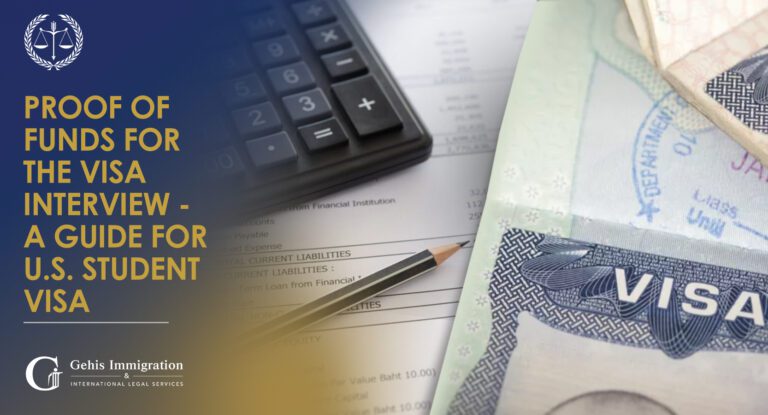Once you have restricted your choice of schools and confirmed your admission, the next step is to apply for an F-1 International Student Visa – to obtain permission to study in the United States. All potential international students must prove that they have the financial means to make a living studying in the United States. This includes coverage for tuition and fees, living costs, and all dependents – who are not working on your studies.
Proof of Funds
To obtain the required proof of funds for your F-1 visa, you must present the proof of funds to yourself or through sponsorship (e.g., a relative who supports your education). It is important that you check this directly at the consulate, as it may vary by country and authority. Here are some general considerations and documents that you should take with you to visit.
Records of liquid assets
The consulate wants to find out if you can afford your education and living expenses. Although there are often no specific documents to prove this, there are several commonly used documents that can help with establishing funding, including:
- Original tax return for the last three years (Form 16)
- Three-year bank records and or statements of fixed deposits from your sponsor (which may also be your parent)
- Pay slips, work letters
- Statements from a chartered accountant
- Scholarships (to be listed on your I-20)
- Property documents
The U.S. government is more concerned with liquid assets, such as savings accounts and current accounts, because it wants to make sure of your easy access to such funds.
Variable investments and title deeds are not normally recommended as evidence of funds. The embassy is trying to find out if you have direct funding to cover the cost of education in the first year and if you have access to the funding needed for the following years to complete the diploma.
Original English Documents
In addition, it is important that all your documents are original, in English (attached as an official translation), and official. Your bank documents should appear on the bank’s letterhead with the account holder’s name, account no, and the total fund’s amount displayed on the forms.
Sponsorship
If you plan to study in the U.S. but do not have enough funds, you can have a sponsor to support you. Many international students have a sponsor, such as a family member, who helps them with the cost of education. Sponsors can be found in the U.S. and beyond.
There are many scholarships available for international students. You can search for the latest list of international scholarships. All you have to do is ensure you are eligible for a scholarship. Requirements include the right positive attitude towards the school and its future career, willingness to succeed in the academy, and more.
Affidavit form for support
If a U.S. citizen sponsors the student, he or she must complete an I-134 affidavit of support form that requires the sponsor to pay any costs that the student is unable to pay. If the student is sponsored with funds outside the United States, the embassy will check to see if there are any restrictions on transferring funds from a particular country. In case of restrictions, the student must have proof that he/she has access to these resources during the study.
Consulate and embassy
The embassy and consulate make the final determination of sufficient records of funds. Even in case you furnish all such papers, they may still refuse a student visa. Check with your school and consulate to make sure you have all the appropriate forms you will need when you come for an F-1 student visa interview, and take professional help if required.
Also, make sure that you are ready to answer all your questions in the best possible way. Be smart, explain things clearly and honestly, and always be in your best shape. If you do so and match your complete documents, you will have a better chance of being accepted for an F-Visa. Please note you should always confirm the latest requirements with official sources, as they may change.
Documents that You Should Bring to the American F1 Student Visa Interview
A list of supporting documents is required for each application. In the case of an F-1 Student Visa interview, the primary documents include your personal data, academic background, professional documents, and financial documents. It is always advisable to stay prepared with all available documents. You must see a complete list of documents required for an American student interview on F1 visas, which is generally available online.
Get Dressed for an F1 Visa Interview
Every conversation starts from the moment you meet your interviewer. Your dress always plays a role in making the first impression. So think carefully about your wardrobe before D-Day and keep the following things in mind.
- Keep it formal, but don’t overdo it. Formal dresses for men include a formal shirt and trousers, and for women can be the same as formal Indian dresses, which can be a simple sari or salwar-kameez.
- Remember, do not choose clothes or clothes that are not suitable for the season. For example, you don’t have to wear the whole suit when your interview is in a hot June. Choose a simple formal shirt and pants instead.
- Choose bright or solid colors. Avoid fluorescent dyes. If the conversation is summer, choose pastel colors. If the conversation is winter, choose full colors. Avoid shaded clothing if it may disturb attention.
- Wear minimum accessories. Your accessories must be as small as possible. Tags, long chains, and jingles are not strictly for women who would like to go for an F1 interview. If you need accessories for religious reasons, keep them to a minimum. Men are advised not to wear chains or heavy bracelets that tinkle.
These are some important tips that you must remember while going to the Visa Interview.






